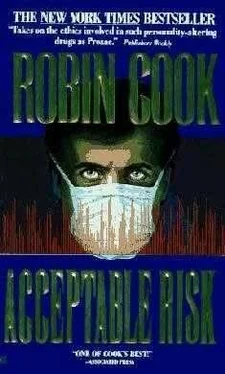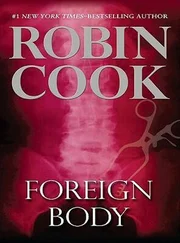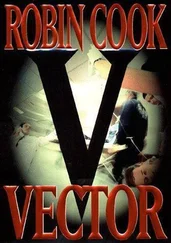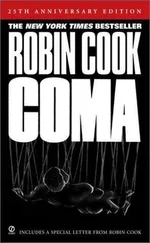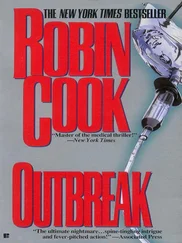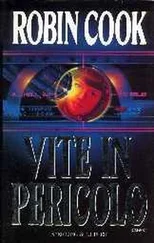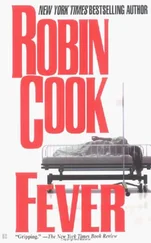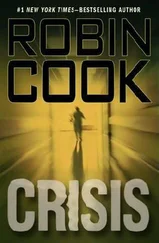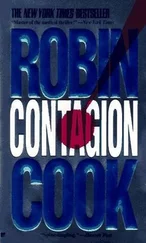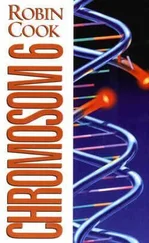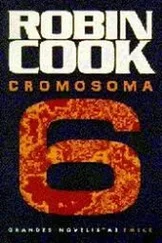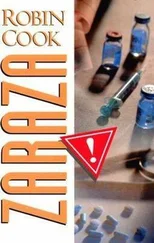Robin Cook - Acceptable Risk
Здесь есть возможность читать онлайн «Robin Cook - Acceptable Risk» весь текст электронной книги совершенно бесплатно (целиком полную версию без сокращений). В некоторых случаях можно слушать аудио, скачать через торрент в формате fb2 и присутствует краткое содержание. Жанр: Триллер, на английском языке. Описание произведения, (предисловие) а так же отзывы посетителей доступны на портале библиотеки ЛибКат.
- Название:Acceptable Risk
- Автор:
- Жанр:
- Год:неизвестен
- ISBN:нет данных
- Рейтинг книги:4 / 5. Голосов: 1
-
Избранное:Добавить в избранное
- Отзывы:
-
Ваша оценка:
- 80
- 1
- 2
- 3
- 4
- 5
Acceptable Risk: краткое содержание, описание и аннотация
Предлагаем к чтению аннотацию, описание, краткое содержание или предисловие (зависит от того, что написал сам автор книги «Acceptable Risk»). Если вы не нашли необходимую информацию о книге — напишите в комментариях, мы постараемся отыскать её.
Acceptable Risk — читать онлайн бесплатно полную книгу (весь текст) целиком
Ниже представлен текст книги, разбитый по страницам. Система сохранения места последней прочитанной страницы, позволяет с удобством читать онлайн бесплатно книгу «Acceptable Risk», без необходимости каждый раз заново искать на чём Вы остановились. Поставьте закладку, и сможете в любой момент перейти на страницу, на которой закончили чтение.
Интервал:
Закладка:
“Absolutely,” Kim assured him.
After a few twists and turns they approached an impressive wrought-iron gate. The gate was suspended from massive stanchions constructed of rough-hewn granite blocks. A high iron fence topped with sharpened spikes disappeared into the dense forest on either side of the road.
“Is this it?” Edward questioned.
“This is it,” Kim answered as she alighted from the car.
“Rather imposing,” Edward called as Kim struggled to open the heavy padlock securing the gate. “And not that inviting.”
“It was an affectation of the age,” Kim yelled back. “People with means wanted to project a baronial image.” After removing the padlock, she pushed the gate open. Its hinges creaked loudly.
Kim returned to the car and they drove through the gate. After a few more twists and turns the road opened up to a large grassy field. Edward stopped again.
“Good Lord,” Edward said. “Now I understand why you said baronial.”
Dominating the enormous field was a huge, multistoried stone house complete with turrets, crenellations, and machicolations. The roof was slate and pockmarked with fanciful decorations and finial-topped dormers. Chimneys sprouted like weeds from all parts of the structure.
“An interesting mélange of styles,” Edward said. “It's part medieval castle, part Tudor manor, part French château. It's amazing.”
“The family has always called it the castle,” Kim explained.
“I can see why,” Edward said. “When you described it as a huge, drafty old place, I had no idea it was going to look like this. This belongs down in Newport with the Breakers.”
“The North Shore of Boston still has quite a few of these huge old houses,” Kim said. “Of course some of them have been torn down. Others have been recycled into condos, but that market is flat at the moment. You can understand why it’s a white elephant for me and my brother.”
“Where’s the old house?” Edward asked.
Kim pointed to the right. In the distance Edward could just make out a dark-brown building nestled in a stand of birch trees.
“What’s that stone building to the left?” Edward asked.
“That was once a mill,” Kim said. “But it was turned into stables a couple of hundred years ago.”
Edward laughed. “It’s amazing you can take all this in stride,” he said. “In my mind anything over fifty years old is a relic.”
Edward started driving again but quickly stopped. He’d come abreast of a fieldstone wall that was mostly overgrown with weeds.
“What’s this?” he asked, pointing at the wall.
“That’s the old family burial ground,” Kim said.
“No fooling,” Edward said. “Can we look?”
“Of course,” Kim said.
They got out of the car and climbed over the wall. They couldn’t use the entrance since it was blocked by a dense thicket of blackberry bushes.
“Looks like a lot of the headstones are broken,” Edward said. “And fairly recently.” He picked up a broken piece of marble.
“Vandalism,” Kim said. “There’s not much we can do about it since the place is vacant.”
“It’s a shame,” Edward said. He looked at the date. It was 1843. The name was Nathaniel Stewart.
“The family used this plot until the middle of the last century,” Kim explained.
Slowly they walked back through the overgrown graveyard. The farther they went the more simple the headstones became and the older they got.
“Is Ronald Stewart in here?” Edward asked.
“He is,” Kim said. She led him over to a simple round headstone with a skull and crossed bones done in low relief. On it was written: Here lyes buried y body of Ronald Stewart y son of John and Lydia Stewart, aged 81 years Dec’d. oct. y 1. 1734.
“Eighty-one,” Edward remarked. “Healthy guy. To reach such a ripe old age he must have been smart enough to stay away from doctors. In those days with all the reliance on bloodletting and a primitive pharmacopoeia, doctors were as lethal as most of the illnesses.”
Next to Ronald’s grave was Rebecca Stewart’s. Her stone described her as Ronald’s wife.
“I guess he got remarried,” Kim said.
“Is Elizabeth buried in here?” Edward asked.
“I don’t know,” Kim said. “No one ever pointed out her grave to me.”
“Are you sure this Elizabeth even existed?” Edward asked.
“I think so,” Kim said. “But I can’t swear to it.”
“Let’s see if we can find her,” Edward suggested. “She’d have to be in this general area.”
For a few minutes they searched in silence, Kim going one way, Edward another.
“Edward!” Kim called.
“Did you find her?” Edward asked.
“Well, sort of,” Kim said.
Edward joined her. She was looking at a headstone similar in design to Ronald’s. It belonged to Jonathan Stewart, who was described as the son of Ronald and Elizabeth Stewart.
“At least we know she existed,” Kim said.
They searched for another half hour but didn’t find Elizabeth’s grave. Finally they gave up and went back to the car. A few minutes later they pulled up in front of the old house. They both got out.
“You weren’t kidding when you said it looked like the Witch House,” Edward said. “It’s got the same massive central chimney, the same steeply pitched gable roof, the same clapboard siding, and the same diamond-shaped panes of glass. And most curious, there is the same protrusion of the second story over the first. I wonder why they did that.”
“I don’t think anyone knows for certain,” Kim said. “The Ward House at the Peabody-Essex Institute has the same feature.”
“The pendants under the overhang are much more decorative than those at the Witch House,” Edward said.
“Whoever turned those had quite a flair,” Kim agreed.
“It’s a charming house,” Edward said. “It has so much more class than the castle.”
Slowly they strolled around the aged building, pointing out its details. In the back Edward noticed a freestanding, smaller structure. He asked if it were equally as old.
“I believe so,” Kim said. “I was told it was for the animals.”
“A mini-barn,” Edward said.
Returning to the front door, Kim had to try multiple keys before she found one that unlocked the door. As she pushed it open it creaked just like the outer gate to the compound.
“Sounds like a haunted house,” Edward said.
“Don’t say that,” Kim protested.
“Don’t tell me you believe in ghosts?” Edward said.
“Let’s just say I respect them,” Kim said with a laugh. “So you go first.”
Edward stepped through the door into a small front hall. Directly ahead was a flight of stairs that twisted up out of sight. On either side were doors. The door on the right led into the kitchen, the one on the left to the parlor.
“Where to first?” Edward asked.
“You’re the guest,” Kim said.
“Let’s check out the parlor,” Edward said.
The room was dominated by a huge fireplace six feet wide. Sprinkled about the room was some colonial furniture as well as lawn tools and other paraphernalia. The most interesting piece of furniture was a canopied bed. It still had some of its original crewelwork bed hangings.
Edward walked over to the fireplace and glanced up the flue. “Still in working order,” he said. Then he looked at the wall above the mantel. Stepping back, he looked at it again.
“Can you see that faint rectangle?” he said.
Kim joined him in the middle of the room and peered at the wall. “I see it,” she said. “Looks like a painting used to hang there.”
“My thought exactly,” Edward said. Wetting the tip of his finger, he tried to smudge the outline. He couldn’t. “It must have hung there a good many years for the smoke to outline it like that.”
Читать дальшеИнтервал:
Закладка:
Похожие книги на «Acceptable Risk»
Представляем Вашему вниманию похожие книги на «Acceptable Risk» списком для выбора. Мы отобрали схожую по названию и смыслу литературу в надежде предоставить читателям больше вариантов отыскать новые, интересные, ещё непрочитанные произведения.
Обсуждение, отзывы о книге «Acceptable Risk» и просто собственные мнения читателей. Оставьте ваши комментарии, напишите, что Вы думаете о произведении, его смысле или главных героях. Укажите что конкретно понравилось, а что нет, и почему Вы так считаете.
